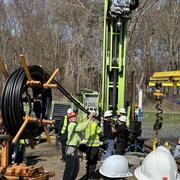John currently is the Groundwater Specialist for the U. S. Geological Survey Water Science Center in New York and is responsible for technical oversight of the Survey’s groundwater program in the State.
John has provided technical assistance to the U. S. Environmental Protection Agency, Army Corp of Engineers, and U.S. Nuclear Regulatory Commission on investigations of contaminated fractured-bedrock aquifers. He has worked with the Geological Survey of Canada in the investigation of transboundary aquifers in New York and Quebec.
In addition, John is an integral part of the geophysical training and technology transfer program of the Hydrogeophysics Branch of the Earth System Processes Division. He has provided support in borehole geophysics to Survey offices throughout the U. S. and in the United Arab Emirates. He recently co-taught a borehole geophysics workshop in northern Iraq for the Iraqi Central and Kurdish Regional Governments that was supported by the U. S. Department of Defense.
Over the past several years, John has made presentations on water-resource issues related to shale-gas development to the U. S. Department of Energy, U. S. Environmental Protection Agency, National Ground Water Association, North American Energy Marketers Association, Empire State Water Well Drillers Association, New York State Department of Environmental Conservation, Pennsylvania Department of Environmental Protection, professional associations of geologists, geophysicists, and engineers, universities, and environmental groups. He also has provided testimony to the New York State Assembly and New York City Council on these issues.















